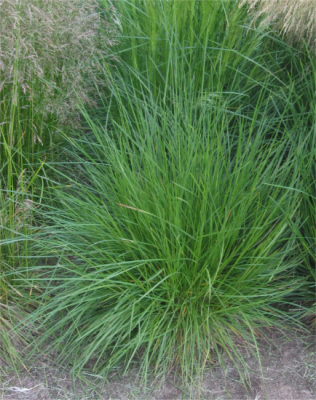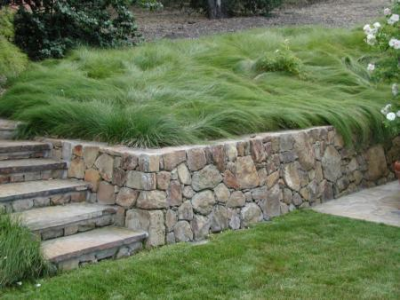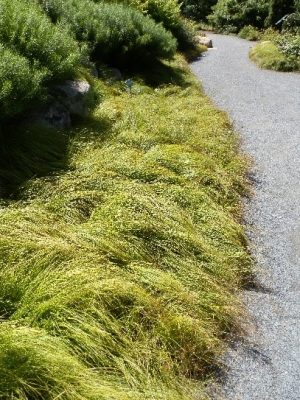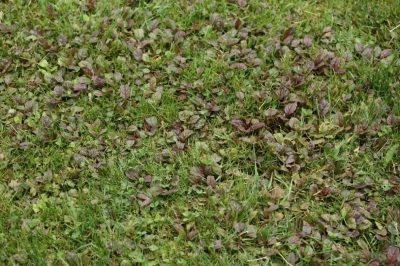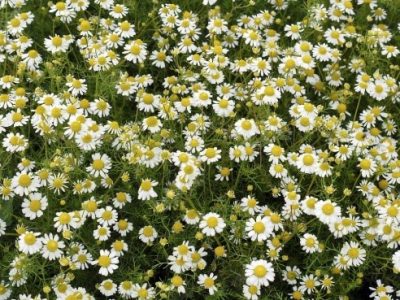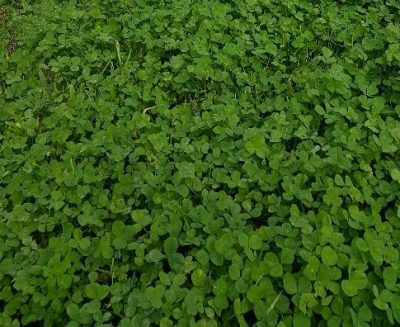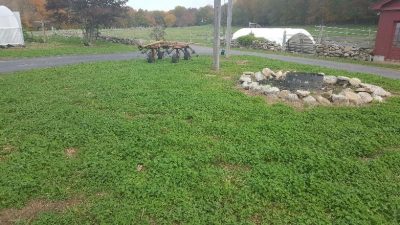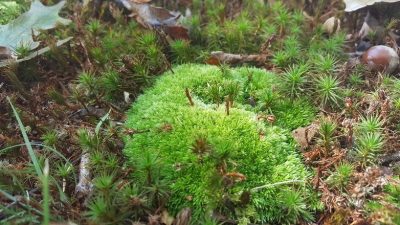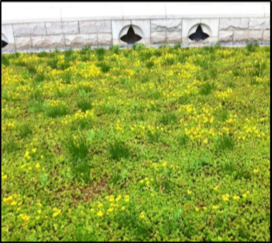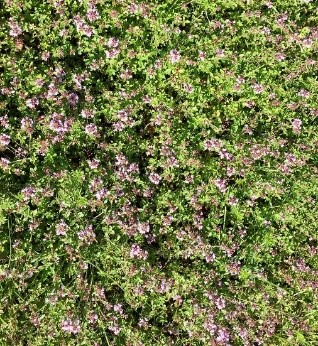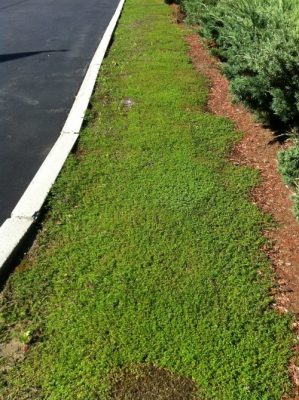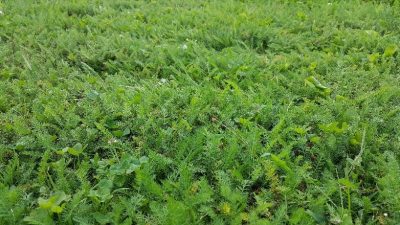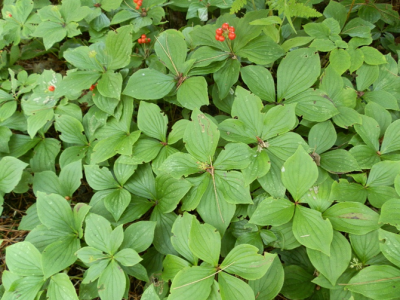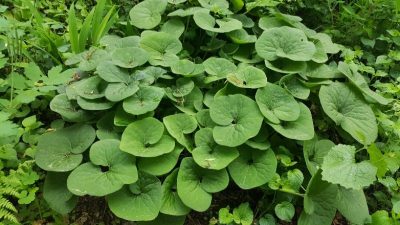By Vickie Wallace and Alyssa Siegel-Miles
Lawns are an integral component of the home landscape. Turf areas contribute recreational space and offer a focus of the landscape design. Grasses also sequester carbon and provide an efficient carbon sink. Nevertheless, large expanses of open lawn areas may serve as surplus in utility and could be transformed for alternate uses. Overtime, reducing the size of the area maintained as a turfgrass lawn can minimize time dedicated to yard maintenance, add an alternative aesthetic look to the landscape, and continue to provide an environmental benefit.

WHY CONSIDER “LAWN OPTIONS?”
Lawns often require significant maintenance and resources to thrive in our climate and soil conditions. While maintained lawn areas have substantial value, they may require a significant level of repeated and repetitive maintenance and expense, including inputs of mowing, irrigation, nutritional amendments (fertilizer, lime), seed for establishment or overseeding, pesticides, and labor. A mown lawn, which lacks flowering, is also unattractive to many native, beneficial pollinators. Outlying areas of a lawn, not used for recreation, may be repurposed with alternative species, to reduce the amount of maintenance required to maintain the site and provide a benefit to the environment.
Benefits of an “alternative” lawn:
- Adds ornamental interest.
- Provides a greater diversity of plant species in the home landscape that provide food and other resources for beneficial wildlife.
- Serves to preserve soil moisture, suppress weeds, protect soil from temperature fluctuation, and provide habitat that hosts a variety of beneficial soil organisms.
- Once established, can serve as a perennial ground cover that has the ability to prevent soil erosion in areas where turf maintenance may be a challenge, such as steep banks or slopes.
- Native plants used as turfgrass alternatives create visual change in the character and beauty of the landscape, reflecting a sense of place and providing a variation in aesthetics.

While there is an initial increase in cost and labor during the transition and establishment of these “alternatives,” over time, an established “re-purposed” lawn may provide an opportunity for reduced input and maintenance. Groundcovers that are well-suited to existing site conditions provide a varied look and texture to the landscape compared to traditional turf areas and may require less fertilizer, pesticides and mowing inputs. Reducing fertilizer and pesticide inputs decreases the potential for nutrients or chemicals to leach into stormwater, creating fewer sources of groundwater pollution. Paring down lawn mowing events cuts down on a significant source of air pollution.
ESTABLISHMENT OF AN ALTERNATIVE LAWN AREA: SITE PREPARATION AND PLANTING
The development and preparation of an “alternative” lawn area is similar to the preparation required of a traditional turfgrass lawn. Correct plant selection, site preparation, and maintenance may reduce the amount of labor required to transition the space to alternate species. In the beginning years, extra care must be taken to ensure establishment success. A heavier seeding rate or a closer spacing of plants (plugs), along with timely fertilizer applications, will encourage plant growth and accelerate establishment. Adequate irrigation is essential during the establishment of new plantings (for one or two growing seasons). The areas should also be maintained as weed-free as possible. Reducing open voids on the soil surface is critical to inhibiting weed establishment.
Several strategies can be utilized to remove or kill unwanted existing vegetation within the area to be transitioned. Time and effort spent on site preparation, to reduce or eradicate competing vegetation, leads to fewer weeds in subsequent years. Weed seeds can lay dormant in the soil for years. Therefore, soil surface disruption should be minimized whenever possible to prevent germination at the soil surface of weed seeds suddenly exposed to sunlight. Less disturbance to the site also will maintain soil structure.
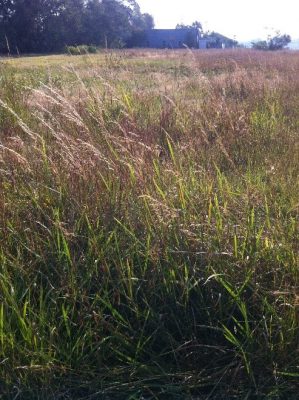
To prepare the area:
- Consider a soil test to determine the pH, existing nutrients and other soil characteristics of the area. For instructions, visit soiltesting.cahnr.uconn.edu or call the UConn Home and Garden Education Center toll-free (877) 486-6271 or the UConn Soil testing lab at (860) 486-4274. Amend or create conditions, based on soil test recommendations, which favor healthy plant growth.
- Define the size and perimeter of the planting area by mowing or staking the perimeter edge. If there is already a lack of vegetation, the outlined shape can be staked with string or marked with field paint.
- Kill or remove the existing vegetation using one of these strategies:
-
- If the area was originally turf, the sod can be harvested with a sod cutter and the area can then be prepared.
- The area can be scalped/mowed at an extremely low height of cut, and the soil can be tilled. However, tilling of the soil will bring dormant weed seeds to the soil surface and expose them to sunlight, which may allow them to germinate and compete with the desired seedlings.
- Treat undesired existing vegetation in the area with a non-selective herbicide such as glyphosate (Round up). It is always important to apply herbicides, whether synthetic or organic, safely and according to manufacturer instructions. Read all pesticide labels prior to use.
- Smother existing vegetation with layers of organic materials or black plastic. Best results are seen when plants are covered for at least two months during the summer.
- Organic materials can include newspaper (multiple layers thick), cardboard, plywood, or a 6 inch layer of seasoned wood chips. Cover newspaper or cardboard with 2-4 inches of weed free mulch or straw, preferably towards the end of spring. This method works well for a small area, but will take time to kill/smother vegetation. It is inexpensive, does not disturb weed seeds, controls erosion, adds organic matter to the soil, and minimizes site disturbance.
- Black plastic can be used in small or medium-sized areas (less than a few thousand square feet) to solarize or kill plants. Disposing of the plastic after the solarization process may be problematic.
Once the area has been prepared, spread the seed or install plants as soon as possible to minimize germination of exposed weed seeds. Any soil disturbance will encourage the germination of weed seeds.
If planting by seed:
- Fall is the preferred time, when temperatures are moderate, soil moisture is more available, and spring and summer weeds provide less competition. If spring seeding, a pre-emergent herbicide should be considered. Check the label to ensure the pre-emergent would not inhibit germination of turfgrasses or “alternatives”.
- Ensure good seed and soil contact.
- Incorporate a starter fertilizer to aid in establishment. Slow release fertilizers, whether organic or synthetic, are preferred over quick-release, water soluble fertilizers. Slow release fertilizers provide an extended, consistent release of nutrients over a longer duration of time.
- Warm season grasses and late summer/fall-flowering plants establish with greater success when seeded or planted in late spring. Cool season perennial grasses and spring flowering plants establish best with late summer/early fall seedings, when summer annual grassy weeds are less of a challenge and weather conditions are usually more favorable for establishment.
- Irrigate appropriately to encourage germination, establishment, and growth of desired crop.
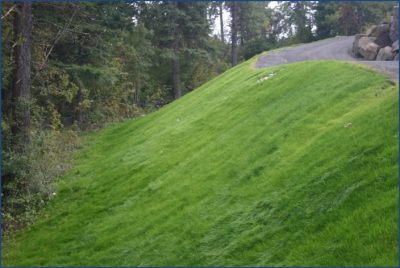
If planting container plants or plugs:
- In Connecticut, mid-late April or early May is usually the ideal time to plant plugs. Planting in early spring allows a full growing season for plants to establish, mature, and set seed. It is imperative, particularly if irrigation is limited, that plugs be incorporated into the landscape as early in the growing season as possible. It is important to establish root growth before the onset of hot summer weather.
- Typically, two or more plugs/ft.2, on 6-8 inch centers, is recommended.
For more information regarding site preparation, planting conditions, and establishment of an alternative plant species into a turfgrass area, see Preparing a Site and Planting a Meadow. This document can serve as a resource whether converting lawn areas to native grasses or flowering plants.
PLANT SELECTION: “ALTERNATIVE” LAWN OPTIONS
The two main categories of plants used as groundcovers in an alternative lawn are grasses and broad-leaved plants.
Factors to consider when choosing plants:
Select plants that, once established:
- Require minimal supplemental irrigation to survive.
- Are disease and insect resistant, hardy and tolerant of the heat in this northeast climate.
- Are adapted for the existing sun, soil and moisture conditions.
- Require little to no pruning.
- Meet the desired size requirements for the location. Consider mature size of the plant in the overall landscape design, especially near areas of traffic, walkways, and building entrances or windows.
Select plants well-adapted to the existing growing conditions, rather than attempting to change site conditions to use mismatched plants.
Another option is to reduce the lawn size in areas where turfgrass growth is challenged. Mulch rings around tree perimeters provide a buffer between woody plants and turf areas, reducing mower and string trimmer damage to trees and shrubs. Using 2-3 in. of shredded bark or other organic mulch material will reduce weeds, retain soil moisture and moderate soil temperatures. Avoid direct contact between mulch and the stems of shrubs and trees.
Cool Season Grasses
| Turfgrass Options | Growing Information |
| Fine fescues - Festuca spp.
|
|
| Tufted hair grass - Deschampsia cespitosa
|
|
Warm Season Grasses
| Turfgrass Options | Growing Information |
| Buffalograss - Bouteloua dactyloides |
|
Sedges - Carex spp.
There are more than 2,000 species of Carex, which naturally persist in a wide range of habitats. Sedges can function within or as a traditional mown lawn, unmown, or in a low maintenance setting. They require no fertilizer or chemicals to establish. Some species require less water than many conventional turfgrasses, while other species tolerate wet, moist areas. Many thrive in shade. Appalachian Sedge (Carex appalachica) and Field Sedge (Carex praegracilis) are found in wetlands, meadows, shorelines & stream banks.
| Turfgrass Options | Growing Information |
| Field sedge - Carex praegracilis |
|
| Pennsylvania sedge - Carex pensylvanica
|
|
Broadleaf species
| Broadleaf Options | Growing Information |
| Common bugle - Ajuga reptans
|
|
| Chamomile – Chamaemelum nobile
|
|
| Clover - Trifolium repens
|
|
| Moss
|
|
| Stonecrop - Sedum spp.
|
|
| Thyme - Thymus spp.
|
|
| Yarrow - Achillea millefolium
|
|
Groundcover Options
In areas of a home property where grass does not grow well, groundcovers may present a solution in many challenging locations. Groundcovers are low-growing plants that spread quickly to form a dense cover. While turfgrass is the most widely used groundcover, it does not grow well in shady locations or in soils high in acidity. Unlike grasses, most groundcover plants are part of the aesthetic design and are not able to serve as a low maintenance lawn (cannot tolerate repeated mowing or wear from foot or other traffic).
Groundcovers are used most frequently for the following locations:
- Shady areas under trees and shrubs. Some groundcovers require less sunlight and less moisture and nutrients than turfgrasses.
- Where it is a challenge to establish turfgrasses due to shade or tree roots.
- Very wet or very dry locations.
| Groundcover Options | Growing Information |
| Bearberry - Arctostaphylos uva-ursi
|
|
| Bunchberry - Cornus canadensis
|
|
| Wild ginger - Asarum canadense
|
|
Glossary
Bunch-type grasses: have a tufted, upright growth habit. Produce tillers from the crown of the plant, with minimal lateral spreading.
Cool Season Grasses: grasses that thrive in areas with cold winters and hot summers, including Northeast U.S., with optimum growth at temperatures between 60 and 75°F (15.5 to 24°C). Cool season grass species include Kentucky bluegrass, perennial ryegrass, fine fescue, and tall fescue.
Rhizomatous (sod-forming) grasses: produce either rhizomes (underground “stems”) or stolons, which extends laterally, enabling the grass to develop a firm sod. Since their growth is often horizontal, their growing points are often low to the ground and avoid removal by defoliation. Rhizomatous-type grasses fill in spots and form a tight-knit web of plants.
Rhizome: an underground, elongated stem (or shoot) that grows horizontally. Adventitious roots arise from the nodes.
Stolon: an elongated stem (or shoot) that grows along the surface of the ground, from which leaves and adventitious roots develop at the nodes, filling in as a tight-knit web of plants.
Warm Season Grasses: grass species with optimum growth at temperatures between 80 and 95°F (27 to 35°C). Thrive in southern U.S. Warm season grass species include buffalograss, bermudagrass, St. Augustine and zoysiagrass.
Bibliography
- Barton, S. & Pineo, R. (Updated 2009). Groundcover Alternatives to Turfgrass. University of Delaware Cooperative Extension. udel.edu/groundcover-alternatives-to-turf-grass
- Berger, H. (2018). Growing Moss in Your Garden. University of Minnesota Extension Anoka County Master Gardeners.
- Brittingham, M. C. (Updated 2005). Wildlife-Friendly Alternatives to Lawn. PennState Extension. extension.psu.edu/meadows-and-prairies-wildlife-friendly-alternatives-to-lawn
- Carignan, C. (2019). Lawns and Microclover. University of Maryland Extension. extension.umd.edu/resource/lawns-and-microclover
- Greenlee, J. (2001). Sedge Lawns: A Sustainable, Low-Maintenance Alternative to Grass. Brooklyn Botanical Garden. bbg.org/gardening/article/sedge_lawns
- Parker, M. M. (2020). How to Create a Moss Pathway. Mississippi State University Extension. extension.msstate.edu/blog/how-create-moss-pathway
- Missouri Botanical Garden. (n.d.). Plant Finder. missouribotanicalgarden.org/plantfinder/plantfindersearch.aspx
- University of Maryland Extension. (n.d.). Invasive Plant Control in Maryland. extension.umd.edu/resource/invasive-species
- Russ, K. & Polomski, R. F. (1999). Low-Maintenance Landscape Ideas. Clemson Cooperative Extension. hgic.clemson.edu/factsheet/low-maintenance-landscape-ideas
- Strickland, J. (Updated 2020). Mulch for the Landscape. NC Cooperative Extension. wayne.ces.ncsu.edu/2017/06/mulch-for-the-landscape
Questions? Contact:
Vickie Wallace
UConn Extension
Extension Educator
Sustainable Turf and Landscape
Phone: (860) 885-2826
Email: victoria.wallace@uconn.edu
Web: ipm.uconn.edu/school
Photos by Alyssa Siegel-Miles and Victoria Wallace.
UConn is an equal opportunity program provider and employer.
©UConn Extension. All rights reserved.
Updated July 2020.

